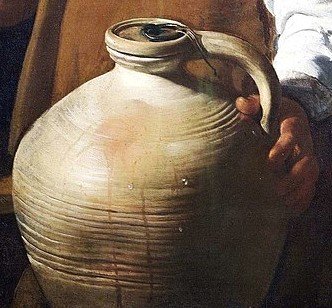The painting, The Waterseller of Seville by Diego Velazquez speaks to me of Lent, and particularly of giving up food, as it recalls the bodegon style of painting. This is a type of Spanish art which often depicts one or more figures with still life elements of foodstuffs, game, and drink, often arranged on a simple slab in a tavern or pantry. However, Velazquez appears to have refined this artistic convention, characterised by a gluttonous abundance, down to the purest and simplest form of human nourishment: water.
The artist’s faithful, detailed and realistic treatment of the lowly people, jugs and bottles in his painting invests them with great dignity. He captures their imperfections with consummate precision: the seller’s ragged poncho and sun-beaten skin, the light glistening on small drops of water and on glass, the slight hollow in the side of the large water bottle, telling of the moment when the potter lifted the heavy, pliably wet, container from the wheel, to dry. The exquisite attention given by the artist to such things invites me to return proper appreciation to that which might be deemed plain, sober, neglected, and marginal. Poverty and abstention are portrayed here as profound, and prestigious.
Furthermore, the love and care contained in the bodies and vessels in this picture enable me to more readily see them in the frame of ‘koinonia’: of communion, intimacy and sharing. The waterseller or aquador was frequently portrayed as a scoundrel or pathetic peddler, who hawked his often dubious wares to an unsuspecting public. However he appears here as a noble, almost priestly figure. Scorned upon and neglected by the wider world, but deserving of our tenderness, sympathy and admiration, he serves water to the intent, reflective boy.
The subtlest gestures – such as the old man and the younger boy both touching the same glass – are painted in such a way as to suggest they are sacred acts. Nevertheless, it is in the secular nature of this silent interchange that the power of the painting lies. There is no overt Christian symbolism here, but rather an invitation to me, as someone of faith, to perceive sacred meaning in the painting, and by extension, in everything around me, to face the world and behold God in all things.
By making his subject the exchange of something as elemental as water, Velazquez reminds us that we are all God’s vessels, and that He resides unreservedly in material flesh, which has the effect of gathering people together in communion.
Questions
What particular detail in the picture draws your attention, and why?
What, from this, will you carry into your day, or this season in the liturgical year?
References:
Painting the Word: Christian Pictures and their Meanings, by John Drury, 1999
Why We Look Down on People Who Don’t Earn Very Much, Audio/Video by The School of Life.
Tom Ingrey-Counter


